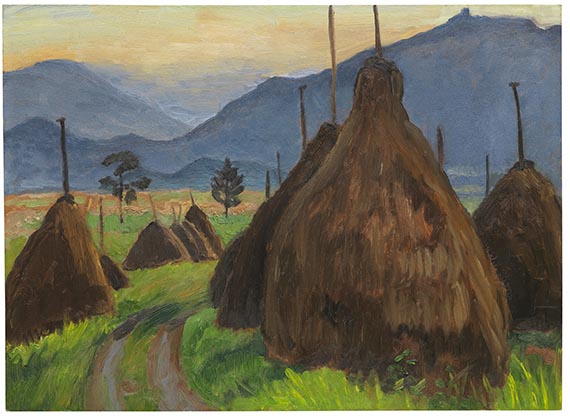43
Gabriele Münter
Heuhocken im Moos, Um 1930.
Oil on cardboard
Estimate:
€ 140,000 / $ 162,400 Sold:
€ 177,800 / $ 206,248 (incl. surcharge)
Heuhocken im Moos. Um 1930.
Oil on cardboard.
With the estate stamp and a label with the stamped number "1288" on the reverse. 32.7 x 45.9 cm (12.8 x 18 in).
• In 1930, Gabriele Münter returned to the Murnau "Russenhaus" for good and revisited beloved themes like the haystacks.
• Münter captured the afternoon atmosphere of the "blue land" with a subtle palette.
• Gabriele Münter visualizes the peasants' work in her very own pictorial language.
• In the 1930s, she found her way back to the powerful expressiveness of her beginnings with the "Blauer Reiter".
Accompanied by a photo confirmation issued by Dr. Hans Konrad Röthel from October 3, 1965.
PROVENANCE: From the artist's estate (with the estate stamp on the reverse).
Galerie Wimmer, Munich 2008.
Private collection Southern Germany (acquired fromt the above in 2008).
LITERATURE: Parke-Bernet Galleries Inc., New York, auction on October 7, 1972, lot 73.
Christie's, London, Auction of German and Austrian Art, October 7, 1999, lot 128.
Oil on cardboard.
With the estate stamp and a label with the stamped number "1288" on the reverse. 32.7 x 45.9 cm (12.8 x 18 in).
• In 1930, Gabriele Münter returned to the Murnau "Russenhaus" for good and revisited beloved themes like the haystacks.
• Münter captured the afternoon atmosphere of the "blue land" with a subtle palette.
• Gabriele Münter visualizes the peasants' work in her very own pictorial language.
• In the 1930s, she found her way back to the powerful expressiveness of her beginnings with the "Blauer Reiter".
Accompanied by a photo confirmation issued by Dr. Hans Konrad Röthel from October 3, 1965.
PROVENANCE: From the artist's estate (with the estate stamp on the reverse).
Galerie Wimmer, Munich 2008.
Private collection Southern Germany (acquired fromt the above in 2008).
LITERATURE: Parke-Bernet Galleries Inc., New York, auction on October 7, 1972, lot 73.
Christie's, London, Auction of German and Austrian Art, October 7, 1999, lot 128.
The farmers could not bring their freshly cut hay straight into the barn from the meadows of the Murnauer Moos, as it was too damp. In order to dry, the hay was piled up in stacks that were up to 4 meters tall. It often stood there well into winter, before the farmers and their horses would haul the grass over the frozen paths into the stables, where it was used as litter. While there is a a car park for hikers near the Ramsachkirchlein today, local farmers used to put up their haystacks, the so-called "Heuhocken" on the village green, at times several hundred of them, when Gabriele Münter first came to Murnau in 1908. As this motif had accompanied Gabriele Münter from the very beginning of her time in the ‘Blue Land’, it is little surprising that she painted it on multiple occasions and in every season. At the beginning of the 1930s, when she had returned to Murnau for good after many years marked by restlessness, Gabriele Münter revisited the motif. Just as it was the case with the Staffelsee or the ‘Blaue Berge’, the haystacks were a reference point in her life in rural Murnau. The “Ödenanger” (village green) is just a short walk from the "Russenhaus" (Russian house), as locals called the house she had bought in 1908, and we can image that she passed by it time and again on her walks. Gabriele Münter chose to depict the view through the haystacks across the bog over to the mountains that she rendered in fine blue tones with the striking rock formation of the "Ettaler Mandl" in the right. An evening sky glowing in a soft shade of pink illuminates the scenery. [EH]
43
Gabriele Münter
Heuhocken im Moos, Um 1930.
Oil on cardboard
Estimate:
€ 140,000 / $ 162,400 Sold:
€ 177,800 / $ 206,248 (incl. surcharge)
Headquarters
Joseph-Wild-Str. 18
81829 Munich
Phone: +49 89 55 244-0
Fax: +49 89 55 244-177
info@kettererkunst.de
Louisa von Saucken / Undine Schleifer
Holstenwall 5
20355 Hamburg
Phone: +49 40 37 49 61-0
Fax: +49 40 37 49 61-66
infohamburg@kettererkunst.de
Dr. Simone Wiechers / Nane Schlage
Fasanenstr. 70
10719 Berlin
Phone: +49 30 88 67 53-63
Fax: +49 30 88 67 56-43
infoberlin@kettererkunst.de
Cordula Lichtenberg
Gertrudenstraße 24-28
50667 Cologne
Phone: +49 221 510 908-15
infokoeln@kettererkunst.de
Hessen
Rhineland-Palatinate
Miriam Heß
Phone: +49 62 21 58 80-038
Fax: +49 62 21 58 80-595
infoheidelberg@kettererkunst.de
We will inform you in time.




 Lot 43
Lot 43 

